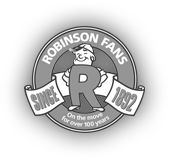Case 1: Cement Application
A kiln induced draft fan would continuously “trip out” due to excessive vibration. After stopping the fan and sand- blasting the areas where buildup was evident, the fan could be restarted and run for another one to five weeks before another untimely ‘trip out.” The customer was losing thousands of dollars–not only in maintenance costs, but also in lack of production–every time the fan shut down.
Solution:
Robinson technicians went to the jobsite with the tools and equipment necessary to analyze the fan system. The diagnostic testing included an impact test (Bump Test) on the fan foundation and the rotor and shaft assembly. Analysis was also performed on the support system for structural integrity. In addition, examination of dampers, expansion joints, bearing pedestals and oil film stiffness was made.
Result:
The findings of this testing led the technicians to conclude that the float bearing pedestal (steel) and foundation (concrete) were in a rocking mode horizontally (both axial and vertical). Robinson recommended that the entire support of the float bearing be increased in size and stiffness to eliminate the sensitivity to material buildup on the fan rotor. Robinson completed this testing in one day. Robinson’s technical service team analyzed the data and submitted a written report to the customer with our recommendations. Robinson enabled a valuable customer to solve what had seemed an insurmountable challenge.






